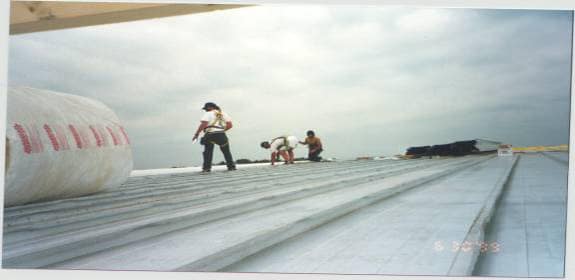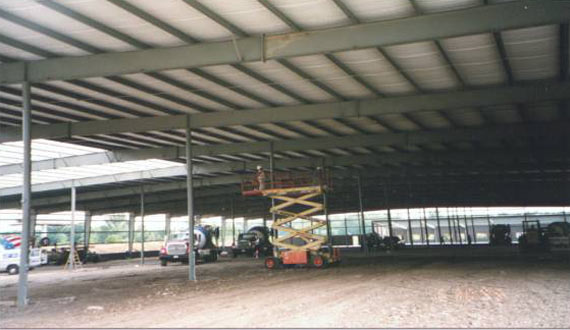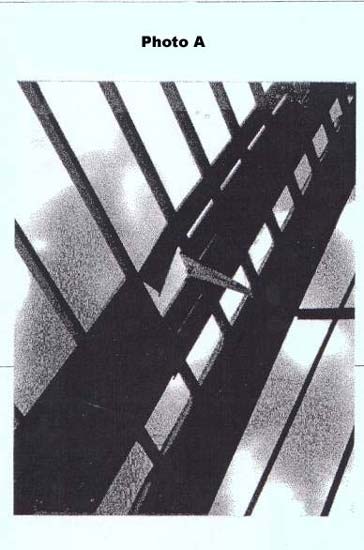Ohio FACE Investigation #990H022 -- Worker Dies After Falling Thru Roof Panel
Investigative Authority:
The Ohio Department of Health (ODH) funded by the National Institute for Occupational Safety and Health (NIOSH) is a participant in the Fatality Assessment and Control Evaluation (FACE) Program. The FACE team conducts investigations of fatal workplace injuries. The goal is to identify the factors that are responsible for or contribute to the workplace injury with the objective of compiling recommendations to prevent future work related injuries.
An ODH investigation included a site visit to obtain photographs of the incident site, interviews with company officials; review of police reports, review of the coroner’s autopsy report; and review of investigation report by Occupational Safety and Health Administration.
Summary:
On May 26, 1999, a 32 year old male construction laborer dies of injuries sustained when he fell thirty feet (30 ft.) from the roof to the floor of a warehouse building that was under construction. The victim along with several of his co-workers was approximately 30 feet off the ground installing roof panels in the northeast corner of the building when the incident occurred. According to witnesses, the victim stepped onto a panel that had not been secured and it gave way causing him to fall. The victim fell to the gravel floor sustaining head, back and internal injuries. The fall occurred at approximately 8:27 a.m. The victim was pronounced dead shortly following the incident.
Recommendations:
- Employers should evaluate each worksite and each job for potential safety hazards and plan accordingly.
- Fall protection must be provided and utilized whenever the potential of a serious fall exists.
- A training program needs to be provided for each employee who might be exposed to fall hazards.
- Employers need to obtain information about workplace hazards to which their employees may be exposed and take appropriate action to protect affected employees from these hazards.
- The employer should set up a company wide safety training program and designate one person to be in charge of it.
Introduction:
On May 26, 1999, a 32 year old male worker of a roofing company died of injuries sustained when he fell through thee roof of a warehouse building that was under construction. On May 31, 1999 the Ohio FACE program was notified of the death by clipping service. On June 30, 1999 the investigators from the Ohio FACE program and NIOSH conducted an investigation. The investigators reviewed the incident with the primary contractor as well as the roofing sub-contractor. Both contractors gave the investigators a tour of the site explaining and showing where and how the incident occurred.
The employer (subcontractor) in this incident had been in business less than five years and employed approximately six employees.
There was no formal company (subcontractor) written safety program or company task-specific safety training. This was the first accident this company has ever had and the first accident that has occurred on any job with the primary contractor.
Investigation:
On Wednesday May 26, 1999 the construction crew for the day met and began the days work at approximately 7:00 a.m. It was a clear sunny day. A total of six roof workers were present the morning of the incident. The roofing materials had been laid out for the morning work. The victim began walking across the roof section that was already in place toward the foreman on the lift. According to the foreman, the victim was concerned that the materials had not been laid out properly. As the co-workers were putting the 50 foot sections of insulation in place, the victim walked out on a metal panel and the incident occurred. According to witnesses, the victim stepped onto a panel that had not been secured and it gave way causing the fall (see photo A). The victim fell to the gravel floor approximately thirty feet below sustaining head, back and internal injuries. Medical personnel responded to the incident at 8:27 a.m. The victim was unconscious and breathing but later went into cardiac arrest. Medical personnel were able to restore a weak pulse and transported the victim to the nearest medical facility where he was pronounced dead.
Cause of Death:
The medical examiner’s report listed the immediate cause of death as blunt trauma to the head, neck and chest.
Recommendations / Discussion
#1 The employer must assess each job and plan that hob with hazards in mind.
Discussion: Assessing and planning with safety in mind forces a fresh look at ways of performing tasks and focuses attention on safety hazards. Employees should be included in this phase as much as possible. If safety hazards exist in a building or worksite over which the employer has no control, the employer must have the correction of such safety hazards specified in the contract. In this situation the subcontractor had no written contract. Free information and assistance is available to the employer through OSHA consultative services. Maintenance of an accident prevention program is required by 29 CFR 1926.200(b)(1).1
#2 Fall protection must be provided and utilized whenever the potential for a serious fall exists.
Discussion: According to 29 CFR 1926.105(a) safety nets are required when the working area is more than 25 feet above the ground and where the use of ladders, scaffolds, catch platforms, temporary floors, safety lines or safety belts is impractical. A safety net should have been suspended under the entire area from which a worker could have fallen.
#3 Employer should provide a training program for each employee who might be exposed to fall hazards.
Discussion: The program should enable each employee to recognize the hazards of falling. The employer should insure that each employee has been trained, as necessary in the following areas:
- nature of fall hazards in the work area
- correct procedures for erecting, maintaining, disassembling and inspecting the protection systems to be used
- use and operation of guardrail systems, personal fall arrest systems, safe net systems, warning line systems, safety monitoring systems, controlled access zones and/or other protection to be used
- the role of each employee in any safety monitoring system when this system is used
- limitations on the use of mechanical equipment during the performance of roofing work on low-sloped roofs
- correct procedures for handling and storage of equipment and materials
#4 Employers should obtain information about workplace hazards to which their employees may be exposed and take appropriate action to protect affected employees from any such hazards.
Discussion: OSHA has consistently maintained that an employer must make a reasonable effort to anticipate the particular hazards to which their employees may be exposed in the course of their scheduled work. Focusing on fall protection in the planning stages of a construction or renovation project will enable an employer to develop measures that protect affected employees from fall hazards. Specifically, an employer should inspect the area to determine what hazards exist or may arise during the work to be performed before permitting employees to work in that area, and then give specific and appropriate instructions to prevent exposure to unsafe conditions. Since different jobs present different hazards, a job safety analysis (JSA) is one method to use. The employer can then determine how to protect employees from hazards specific to that job.
#5 The employer must provide training which addresses hazards at each job site.
Discussion: The employer should set up a safety program and designate one person to be responsible for safety at each worksite. Training should include measures to ensure physical safety and use of equipment, as well as dangers of exposure to hazardous substances. This is mandated by 29 CFR 1926.21(b)(2).2. The employer’s emphasis on safety will encourage employees to use safe work practices even when the employer is not present.
REFERENCES
Office of the Federal Register: Code of Federal Regulations, Construction 1926 US Department of Labor, Occupational Health and Safety Administration, Washington D.C.

Above The Roof Line

Below The Roof Line

A View Of The Accident Scene From Below
Please use information listed on the Contact Sheet on the NIOSH FACE web site to contact In-house FACE program personnel regarding In-house FACE reports and to gain assistance when State-FACE program personnel cannot be reached.
